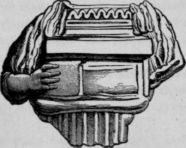MUSICAL INSTRUMENTS - online book
The History And Development Of Musical Instruments From The Earliest Times.
| Share page | Visit Us On FB |
|
24 |
MUSICAL INSTRUMENTS. |
||
|
seated on one of the ancient terra-cottas excavated in Tarsus, Asia-minor, some years since, and here engraved. These
remains are believed to be about 2000 years old, judging from the figures upon them, and from some coins struck about 200 years B.C. having been found embedded with them. "We have therefore before us, probably, the oldest representation of a bag-pipe hitherto discovered. The Trumpet. Three kinds are mentioned in the Bible, viz. the kcren, the sliopJiar, and the chatzozcrah. The first two were more or less curved and might properly be considered as horns. Most commentators are of opinion that the kcrcn—made of ram's horn—was almost identical with the s/iop/iar, the only difference being that the latter was more curved than the former. The shophar is especially remarkable as being the only Hebrew musical instrument which has been preserved to the present day in the religious services of the Jews. It is still blown in the synagogue, as in lime of old, at the Jewish new-year's festival, according to the command of Moses (Numb. xxix. 1). The chatzozcraJi was a straight trumpet, about two feet in length, and was sometimes made of silver. Two of these straight trumpets are shown in the famous triumphal procession after the fall of Jerusalem on the arch of Titus, engraved on the next page.
The Drum. There can be no doubt that the Hebrews had several kinds of drums. We know, however, only of the tip/i, which appears to have been a tambourine or a small hand-drum like the Egyptian darabouka. In the English version of the Bible the word is rendered timbrel or tabrct. This instrument was especially used in processions on occasions of rejoicing, and also
 |
|||